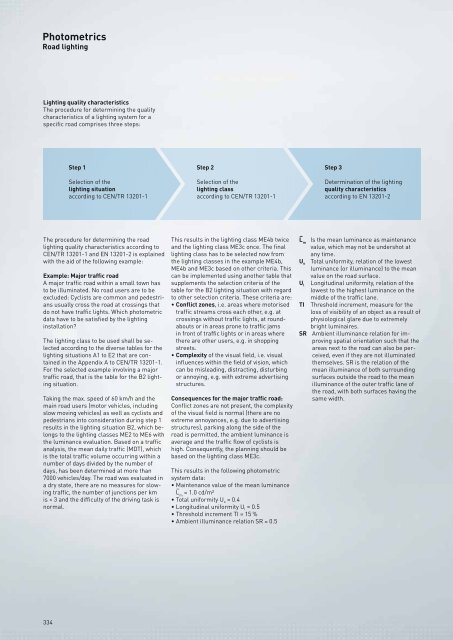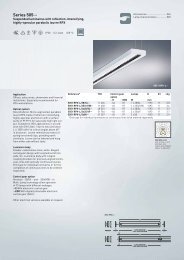TRILUX Luminaires - Proljus AB
TRILUX Luminaires - Proljus AB
TRILUX Luminaires - Proljus AB
You also want an ePaper? Increase the reach of your titles
YUMPU automatically turns print PDFs into web optimized ePapers that Google loves.
Photometrics<br />
Road lighting<br />
Lighting quality characteristics<br />
The procedure for determining the quality<br />
characteristics of a lighting system for a<br />
specific road comprises three steps:<br />
The procedure for determining the road<br />
lighting quality characteristics according to<br />
CEN/TR 13201-1 and EN 13201-2 is explained<br />
with the aid of the following example:<br />
Example: Major traffic road<br />
A major traffic road within a small town has<br />
to be illuminated. No road users are to be<br />
excluded: Cyclists are common and pedestrians<br />
usually cross the road at crossings that<br />
do not have traffic lights. Which photometric<br />
data have to be satisfied by the lighting<br />
installation?<br />
The lighting class to be used shall be selected<br />
according to the diverse tables for the<br />
lighting situations A1 to E2 that are contained<br />
in the Appendix A to CEN/TR 13201-1.<br />
For the selected example involving a major<br />
traffic road, that is the table for the B2 lighting<br />
situation.<br />
Taking the max. speed of 60 km/h and the<br />
main road users (motor vehicles, including<br />
slow moving vehicles) as well as cyclists and<br />
pedestrians into consideration during step 1<br />
results in the lighting situation B2, which belongs<br />
to the lighting classes ME2 to ME6 with<br />
the luminance evaluation. Based on a traffic<br />
analysis, the mean daily traffic (MDT), which<br />
is the total traffic volume occurring within a<br />
number of days divided by the number of<br />
days, has been determined at more than<br />
7000 vehicles/day. The road was evaluated in<br />
a dry state, there are no measures for slowing<br />
traffic, the number of junctions per km<br />
is < 3 and the difficulty of the driving task is<br />
normal.<br />
334<br />
Step 1<br />
Selection of the<br />
lighting situation<br />
according to CEN/TR 13201-1<br />
Step 2<br />
Selection of the<br />
lighting class<br />
according to CEN/TR 13201-1<br />
This results in the lighting class ME4b twice<br />
and the lighting class ME3c once. The final<br />
lighting class has to be selected now from<br />
the lighting classes in the example ME4b,<br />
ME4b and ME3c based on other criteria. This<br />
can be implemented using another table that<br />
supplements the selection criteria of the<br />
table for the B2 lighting situation with regard<br />
to other selection criteria. These criteria are:<br />
• Conflict zones, i.e. areas where motorised<br />
traffic streams cross each other, e.g. at<br />
crossings without traffic lights, at roundabouts<br />
or in areas prone to traffic jams<br />
in front of traffic lights or in areas where<br />
there are other users, e.g. in shopping<br />
streets.<br />
• Complexity of the visual field, i.e. visual<br />
influences within the field of vision, which<br />
can be misleading, distracting, disturbing<br />
or annoying, e.g. with extreme advertising<br />
structures.<br />
Consequences for the major traffic road:<br />
Conflict zones are not present, the complexity<br />
of the visual field is normal (there are no<br />
extreme annoyances, e.g. due to advertising<br />
structures), parking along the side of the<br />
road is permitted, the ambient luminance is<br />
average and the traffic flow of cyclists is<br />
high. Consequently, the planning should be<br />
based on the lighting class ME3c.<br />
This results in the following photometric<br />
system data:<br />
• Maintenance value of the mean luminance<br />
L – = 1.0 cd/m²<br />
m<br />
• Total uniformity Uo = 0.4<br />
• Longitudinal uniformity Ul = 0.5<br />
• Threshold increment TI = 15 %<br />
• Ambient illuminance relation SR = 0.5<br />
Step 3<br />
Determination of the lighting<br />
quality characteristics<br />
according to EN 13201-2<br />
L – m Is the mean luminance as maintenance<br />
value, which may not be undershot at<br />
any time.<br />
U o Total uniformity, relation of the lowest<br />
luminance (or illuminance) to the mean<br />
value on the road surface.<br />
U l Longitudinal uniformity, relation of the<br />
lowest to the highest luminance on the<br />
middle of the traffic lane.<br />
TI Threshold increment, measure for the<br />
loss of visibility of an object as a result of<br />
physiological glare due to extremely<br />
bright luminaires.<br />
SR Ambient illuminance relation for improving<br />
spatial orientation such that the<br />
areas next to the road can also be perceived,<br />
even if they are not illuminated<br />
themselves. SR is the relation of the<br />
mean illuminance of both surrounding<br />
surfaces outside the road to the mean<br />
illuminance of the outer traffic lane of<br />
the road, with both surfaces having the<br />
same width.



